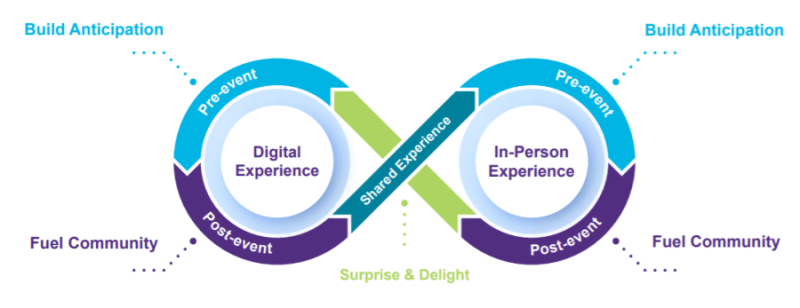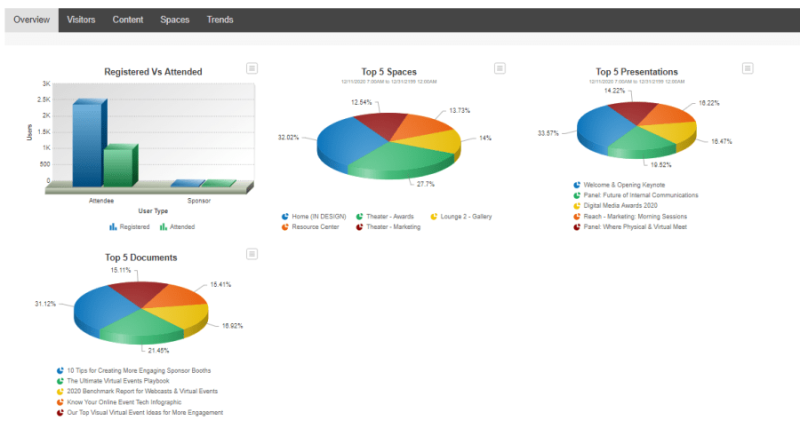The events industry has evolved. Soon, nearly every event will be delivered through multiple channels – the in-person and digital channels.
This poses a challenge for many marketers and event planners: how can you create valuable, engaging content that successfully blends these channels into one experience?
We hosted a live webinar in partnership with The American Marketing Association. Experts from Notified and One Smooth Stone discussed the future of events and ways that event planners can deliver successful “always on” experiences powered by digital channels.
Read on to hear their top tips and tricks and to learn how you can plan and execute a successful hybrid event strategy.
What Are Hybrid Events?
Let’s start with a definition. We’ve spoken about hybrid events before.
In a nutshell, hybrid events are events that blend physical experiences with digital components. Pre-COVID, the most obvious example of hybrid events were live sports, award shows, and variety television shows (like SNL); the physical event was broadcast to a remote audience, creating two different viewing experiences.
Post-COVID, hybrid events will look very different. Event planners are looking for ways to create meaningful, impactful experiences that fully immerse BOTH audiences in an environment. In many ways, hybrid events are not a single moment in time (as we may have previously defined “event”). Instead, they are launch pads to foster “always-on” engagement and interaction.
And this is where we run into challenges. The idea of creating an always-on experience is daunting. Where do we start?
The Life Cycle of Hybrid Events
The most crucial component of “new” hybrid events is this always-on mindset.

Instead of building up excitement for one moment in time, then subsequently abandoning that excitement to move on to the next calendar item, hybrid events allow us to engage and interact with audiences both before and after the “headlining” show; providing audiences with access to on-demand content in the lead-up to your show, save the “big ticket” items for the live day, and share session highlights after.
Ideally, the full lifecycle of your event will look something like this:
Pre-Event: Build Anticipation
- Share micro-events (like webinars and short talks)
- Conduct speaker interviews
- Create scheduled networking opportunities
- Distribute surveys and polls
- Encourage game participation
- Share new agenda details
Live Event: Surprise and Delight
- Share live programming
- Foster active community engagement
- Enable personalization
- Encourage game participation
- Schedule networking opportunities
- Create a shared experience between the in-person and virtual audiences
Post-Event: Fuel Your Community
- Share attendee and speaker interviews
- Post session highlights to social and other channels
- Distribute surveys and collect testimonials
- Create a nurture program
- Share the on-demand replay
- Create micro-events
- Re-purpose event content across other channels
The Shared Experience Framework
In order to create successful hybrid events, there are a few tactical steps you can follow. We call these steps the shared experience framework.
Here’s how it works:
- Understand the current internal and external environment.
First, take a moment to understand the environment in which your event will live. This will help you make every other decision moving forward. What market forces are influencing your event? What are your competitors doing (and doing well)? What is your target audience looking for?
Next, take a moment to analyze your current and historical event data, so you can see what has and has not worked for you in the past. How can you incorporate these into your next event?
Are there internal team dynamics to consider? How many hands do you have to help you develop this event? What stakeholders will want a say?
Once you understand your event requirements, you can start to make decisions.
- Determine your event objectives.
Once you understand what you are trying to accomplish with your event, you can begin to determine event objectives. As with anything else, your event objectives should line up with your overarching business goals. How will this event fit into your annual strategies? Importantly, you should make these objectives measurable. What metrics will determine the success of your event?
Your objectives will serve as the “North Star” for the rest of the steps in this framework.
- Design your event.
The next step in this framework is designing your event. Typically, when we think of design, we think of the creative components that build an environment: the logos, images, colors, and overall flow of a space are all important.
When it comes to hybrid events, however, there is more to consider. As with everything else, your design should directly relate back to your objectives; how will each piece help you meet the metrics for success? Design with your audience in mind; each audience will experience the event differently, and it is critical to consider ways to optimize both remote and in person engagement. However, even more critically, you must be intentional in designing opportunities for your audience to share experiences. What content do they share? What games, polls, or surveys connect the two audiences?
Further, it is critical to design your sponsorship and monetization opportunities. We like to say “if it’s customizable, it’s monetizable.” How will you create value for your sponsors? What does success look like for THEM, and how can you help deliver that?
In a hybrid event, “design” means more than visual elements; it is the consideration of every single piece of the event puzzle and how they will interact to engage and delight your audiences.
- Deliver a memorable experience.
Plans mean nothing without execution. Delivering an excellent hybrid event means more than simply sharing content across the two channels. In order to truly create an immersive, engaging experience, you must consider all available interactive features and capabilities available to you. For example:
- Securing onsite event management as well as production and AV services
- Ensuring accessibility with translation and captioning
- Hosting a live event “news desk”
- Integrating with social channels
- Conducting and sharing on-site interviews
- Facilitating matchmaking services to connect attendees with similar backgrounds
- Encouraging 1 to 1 video chats between virtual participants
- Hosting breakout sessions
- Livestreaming keynotes and other high-value presentations
As you consider possible event activities, it’s important to examine what will create the most value for each individual set of attendees. How can you maximize both experiences, so neither audience feels that they have somehow “missed out” on key components of the event?
Take live sports for example. There are key benefits to attendees of the in-person competition as well as experiences limited to the remote audience. While live attendees have the benefit of seeing the players in person and interacting face-to-face with their fellow fans, remote viewers receive a more holistic view of the game, detailed live commentary, and replay capabilities.
Planning, creating, and delivering value for BOTH experiences ensures that each audience is satisfied with the event.
- Measure your success.
The prevalence of virtual environments means that the event industry is swimming in new data. While some of this data might have been available before, it is more digestible thanks to the robust reporting capabilities of digital platforms.
Now, it’s time to USE those metrics.
At the beginning of the planning process, you should have outlined your objectives and your success metrics. Now, it’s time to check in on those objectives.
Any good virtual event platform will allow you to see how many people registered and attended your event. Those are basic success metrics. However, things get more interesting when you dive deeper: what sessions were the most popular? Which booths attracted the most visitors? What pieces of content were most frequently downloaded?
Examining these numbers will help you learn and design better events in the future.

- Reinforce your content.
In the past, measure would have been one of the last steps in the event lifecycle. Once you report on and determine the success of your event, you can move on to the next project.
Now, hybrid events give us the opportunity to create always-on engagement and the ability to reinforce the importance of our content. What were the most valuable pieces of content created for your event? The most memorable experiences?
After your event concludes, you can now re-purpose that content into a nearly never ending stream of engagement opportunities. Share session clips on social media or create a YouTube mini series. Share screenshots and testimonials. Use polls and surveys to dictate new content creation. And don’t forget to direct audiences to the on-demand environment.
Summary: The Future of Business Events is Hybrid
There are a lot of remaining questions about the future of hybrid events and what this new landscape might entail. Event planners may be concerned about the prospective costs or staff resources available to incorporate these new content streams into their event strategies.
However, the benefits of hybrid events far outweigh the costs; in the past, when a closing keynote ended and the audience left, the event was simply over. Now, on-demand streaming allows you to continue engaging that audience long after the in-person component concludes.
Hybrid events allow you to create branded, unique experiences for both audiences that create lasting memories and provide value.
Here are a few helpful resources to help you get started with hybrid events:
-
View the full hybrid event panel discussion on-demand here.
-
Check out our Hybrid Events FAQ if you have questions on how to plan a successful hybrid experience.
-
Check out the Events in a Hybrid World Solution Sheet
Get a Demo of Our End-to-End Event Platform
Whether you’re hosting virtual or hybrid events to reach customers, employees, investors, or partners, Notified is here to help bring your vision to life.
We host over 100,000 events annually on behalf of thousands of customers around the world while providing dedicated support with a focus on data.
All event solutions include:
-
Dedicated project manager
-
Interactive environments with live & on-demand programming
-
Flexible branding and personalization options
-
Accessibility – anytime, anywhere, and from any device
-
Robust analytics and reporting
-
And, from strategy and planning to implementation and delivery, our consulting services team supports you every step of the way.
Contact us today to set up a free demo and learn more about our services.
